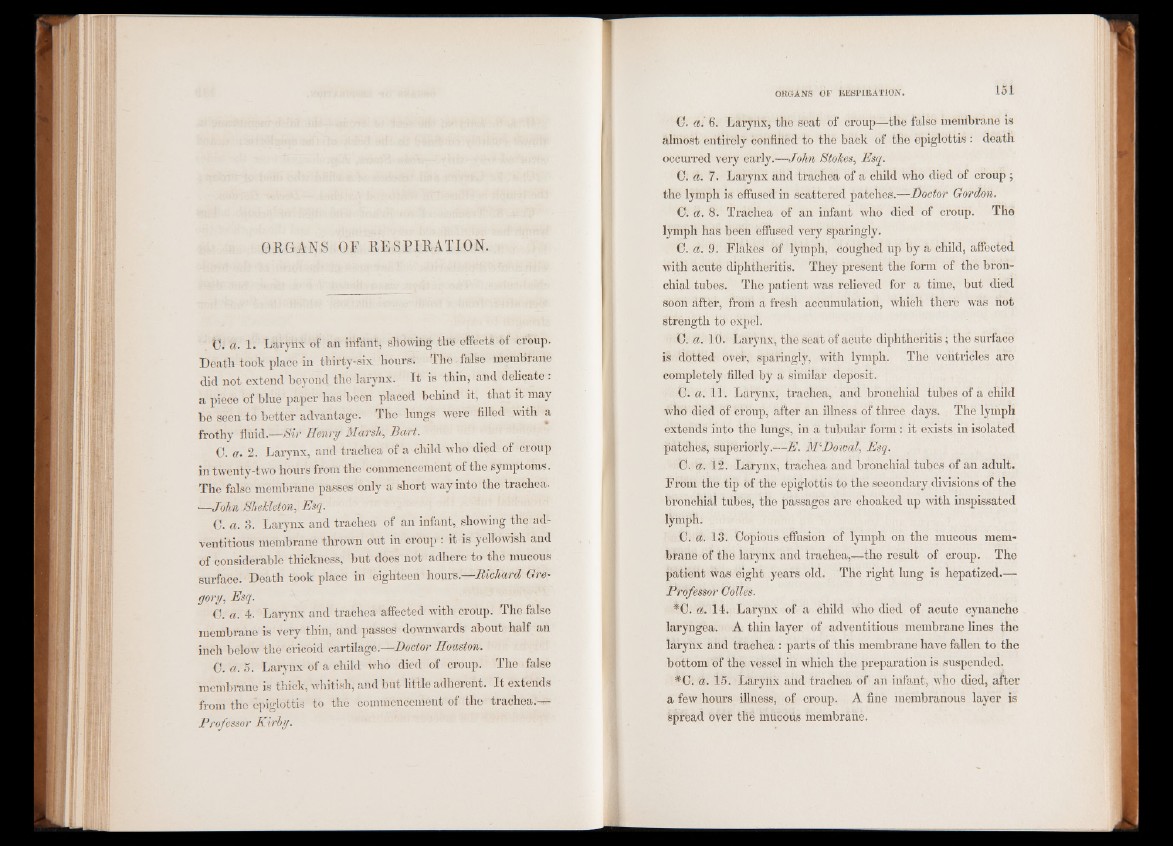
ORGANS OF RESPIRATION.
0. a. 1. Larynx of an infant* showing the effects of croup.
Death took place in thirty-six hours. The.false membrane
did not extend beyond the larynx. It is thin, and delicate :
a piece of blue paper has been placed behind it, that it may
be seen to better advantage. The lungs were filled with a
frothy fluid.—Sir Henry Marsh, Bart.
C. a. 2. Larynx, and trachea of a child who died of croup
in twenty-two hours from the commencement of the symptoms.
The false membrane passes only a short way into the trachea.
•—John Bhehleton, Esq.
0. a. 3. Larynx and trachea of an infant, showing the adventitious
membrane thrown out in croup : it is yellowish and
of considerable thickness, but does not adhere to the mucous
surface. Death took place in eighteen hours.—Bichard Gregory,
Esq.
0. a. 4. Larynx and trachea affected with croup. The false
membrane is very thin, and passes downwards about half an
inch below the cricoid cartilage.—Doctor Houston.
0. a. 5. Larynx of a child who died of croup. The false
membrane is thick, whitish, and but little adherent. It extends
from the epiglottis to the commencement of the trachea. ■
Professor Kirby.
0. a. 6. Larynx, the seat of croup—the false membrane is
almost entirely confined to the back of the epiglottis: death
occurred very early.—John Stokes, Esq.
0. a. 7. Larynx and trachea of a child who died of croup ;
the lymph is effused in scattered patches.—Doctor Gordon.
C. a. 8. Trachea of an infant who died of croup. The
lymph has been effused very sparingly.
0. a. 9. Flakes of lymph, coughed up by a child, affected
with acute diphtheritis. They present the form of the bronchial
tubes. The patient was relieved for a time, but died
soon after, frorh a fresh accumulation, which there was not
strength to expel.
0. a. 10. Larynx, the seat of acute diphtheritis; the surface
is dotted over, sparingly, with lymph. The ventricles are
completely filled by a similar deposit.
0. a. 11. Larynx, trachea, and bronchial tubes of a child
who died of croup, after an illness of three days. The lymph
extends into the lungs, in a tubular form : it exists in isolated
patches, superiorly.—E. MiDoival, Esq.
0. a. 1 2 . Larynx, trachea and bronchial tubes of an adult.
From the tip of the epiglottis to the secondary divisions of the
bronchial tubes, the passages are choaked up with inspissated
lymph.
0. a. 13. Copious effusion of lymph on the mucous membrane
of the larynx and trachea,—the result of croup. The
patient Was eight years old. The right lung is hepatized.—
Professor Cdlles.
*C. a. 14. Larynx of a child who died of acute cynanche
laryngea. A thin layer of adventitious membrane lines the
larynx and trachea : parts of this membrane have fallen to the
bottom of the vessel in which the preparation is suspended.
#C. a. 15. Larynx and trachea of an infant, wTho died, after
a few hours illness, of croup. A fine membranous layer is
spread over the mucous membrane.